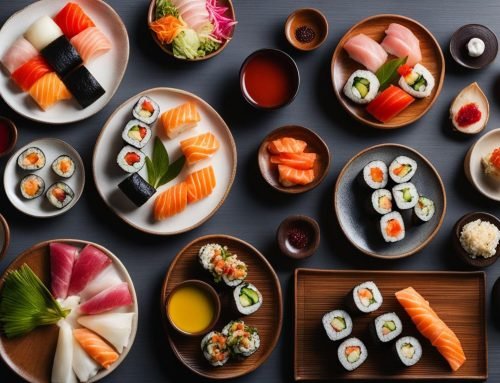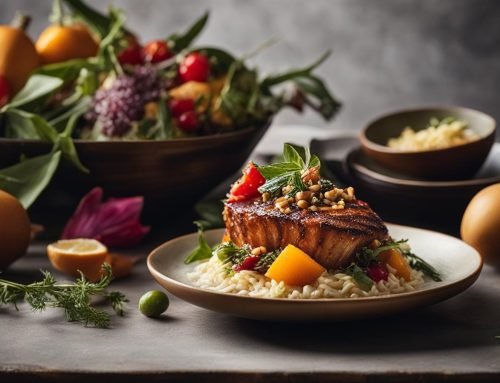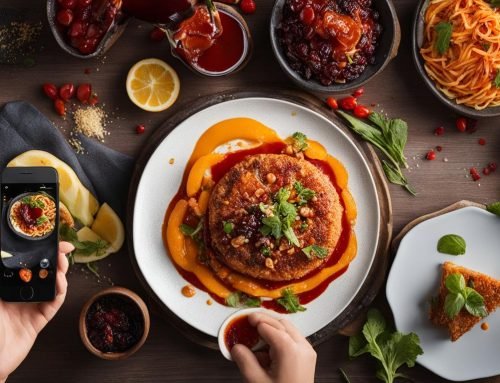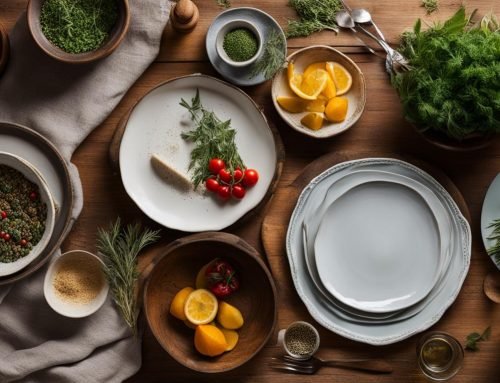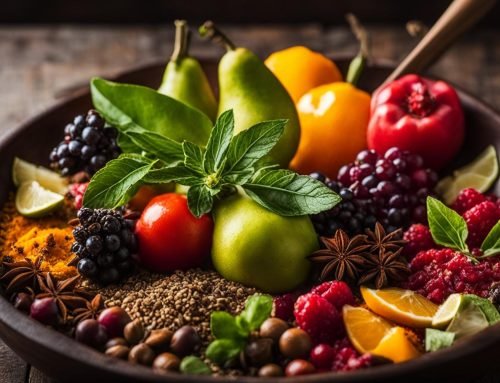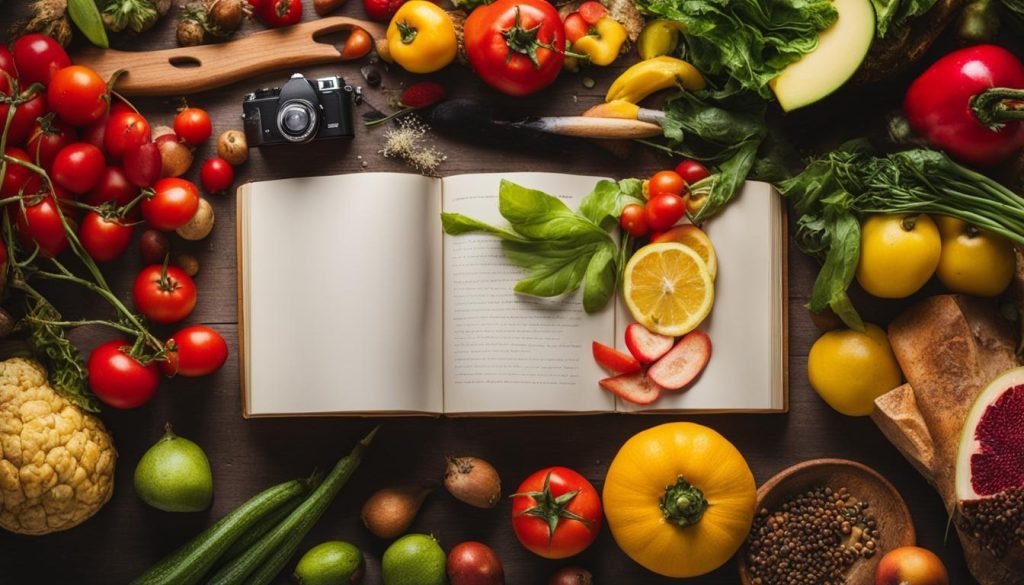
As a food photographer, staying creatively inspired is essential to produce captivating images. To keep your artistic spark alive, it’s crucial to challenge yourself and explore new techniques continuously. This article will provide you with valuable tips and ideas to ignite your creativity and take your food photography to the next level.
Key Takeaways:
- Continuous experimentation is key to maintaining creative inspiration.
- Engaging in personal projects and collaborations with other creatives can provide fresh perspectives.
- Exploring different lighting techniques and using simple gear can create unique and captivating images.
- Observation is crucial in finding inspiration, as beauty can be found everywhere.
- As a food photographer, pushing yourself to try new ideas and techniques is essential for growth and development.
13 Creative Food Photography Ideas for Your Next Photoshoot
When it comes to food photography, creativity and innovation are key to capturing visually stunning images. If you’re looking for fresh ideas to elevate your photoshoots, here are 13 creative food photography ideas to inspire you:
- Capture floating ingredients: Create an ethereal effect by photographing ingredients suspended in mid-air.
- Construct edible landscapes: Build miniature scenes using food to create unique and captivating images.
- Create a sweet splash: Add excitement to your photos by capturing sauces or syrups splashing onto food.
- Hide surprising ingredients: Conceal unexpected elements inside dishes to surprise and intrigue your audience.
- Arrange ingredients for food portraits: Use different ingredients to compose intricate food portraits.
- Explore the journey of food: Document the process from farm to table, showcasing the different stages of preparation.
- Capture melting delights: Freeze the moment as ice cream or chocolate melts for a mouthwatering effect.
- Arrange colorful foods like an artist’s palette: Play with vibrant hues and create visually striking compositions.
- Turn food into a canvas: Use edible dyes or sauces to paint intricate designs on your dishes.
- Utilize mirrors for infinite reflections: Experiment with mirrors or reflective surfaces to add depth and complexity to your images.
- Experiment with patterns: Create visual interest by arranging ingredients in repetitive and eye-catching patterns.
- Capture ingredient explosions: Freeze the moment of an ingredient bursting or splattering for a dynamic and energetic shot.
- Tell stories through food photography: Use props and composition to create narratives and evoke emotions in your photos.
These creative food photography ideas are just the beginning. Let your imagination run wild, and don’t be afraid to try new techniques and concepts. With a dash of innovation and a pinch of experimentation, you can create truly captivating food photographs that inspire and delight.
Use Reflections for Stylish Commercial Shots
Reflections can be your secret weapon when creating stylish and visually captivating commercial food shots. You can add a unique and dynamic touch to your photography by strategically incorporating reflective surfaces. Consider shooting on shiny countertops or using mirrors to create natural reflections that enhance the depth and interest of your images.
Experiment with backdrops with reflective surfaces, such as metallic sheets or glossy tiles, to achieve a mirrored effect that makes the food stand out. Additionally, incorporating water in the scene can create stunning natural reflections, especially when shooting from a low angle.
“Using reflective surfaces in food photography adds a touch of sophistication and elegance. It helps create a polished look and draws attention to the delicious details of the dish.” – Food Photography Expert
In addition to using reflective surfaces, you can also play with various props and lighting techniques to amplify the reflective elements in your shots. Glassware, metallic accents, and different types of lighting can all contribute to creating visually appealing and dynamic commercial food photographs.
Explore the Art of Reflection
If you’re looking to take your food photography to the next level, consider exploring the art of reflection. By utilizing reflective surfaces, experimenting with different props and lighting techniques, and incorporating water into your compositions, you can achieve stylish and captivating commercial shots that are sure to leave a lasting impression.
How to Do Food Styling? 20 Best Styling Tips
Food styling is an essential aspect of creating visually appealing food photography. It involves arranging and presenting food in an appealing and visually enticing manner. To achieve great food styling, some several tips and techniques can help elevate your images.
1. Plan and gather inspiration:
Before starting your food styling, take the time to plan and gather inspiration. Look for ideas in cookbooks, magazines, and online platforms. Creating a mood board can help you visualize the overall look and feel you want to achieve.
2. Choose suitable props:
Props play a crucial role in food styling. Select props that complement the food and enhance the overall composition. Consider using plates, cutlery, napkins, and other accessories to add depth and interest to your images.
3. Select fresh and high-quality ingredients:
The quality of ingredients can significantly impact the outcome of your food styling. Choose fresh, visually appealing ingredients that convey the desired message and evoke a sensory experience.
4. Consider composition and arrangement:
Composition and arrangement are vital elements of food styling. Pay attention to the balance, color harmony, and overall visual flow of the scene. Experiment with different arrangements to find the most visually appealing composition.
5. Layer ingredients strategically:
Layering ingredients can add depth and texture to your food photography. Consider adding garnishes, sauces, or toppings to create visual interest and enhance the overall presentation of the dish.
“Food styling is an art form that involves arranging and presenting food in an appealing and visually enticing manner.”
6. Pay attention to color contrast:
Color contrast can make your images visually striking. Experiment with complementary or contrasting colors to create a dynamic and visually appealing composition. Consider using colorful ingredients and props to add vibrancy to your food styling.
7. Use lighting to highlight the food:
Lighting plays a crucial role in food photography. Experiment with different lighting techniques to highlight the textures, colors, and details of the food. Natural light, diffused light, or artificial light sources can all create other effects and moods in your styling.
8. Add finishing touches and small details:
Small details can make a big difference in food styling. Pay attention to the finishing touches, such as adding a sprinkle of herbs, a drizzle of sauce, or a dusting of powdered sugar. These small details can elevate the overall presentation of the dish.
9. Utilize tools for precise adjustments:
Tools like tweezers or brushes can be handy for precise adjustments in your food styling. Use them to arrange garnishes, adjust the position of ingredients, or clean up any stray crumbs or spills.
10. Experiment with different props:
Don’t be afraid to think outside the box and use unconventional props in your food styling. Consider using fabrics, flowers, or interesting textures to add visual interest and unique elements to your compositions.
- Plan and gather inspiration.
- Choose suitable props.
- Select fresh and high-quality ingredients.
- Consider composition and arrangement.
- Layer ingredients strategically.
- Pay attention to color contrast.
- Use lighting to highlight the food.
- Add finishing touches and small details.
- Utilize tools for precise adjustments.
- Experiment with different props.
By following these food styling tips, you can enhance the overall presentation and visual appeal of your food photography. Remember to continuously experiment, practice, and refine your skills to create captivating and stunning food images.
Reinvent Food Preparation Methods for New Ideas
When it comes to food photography, exploring and reinventing food preparation methods can provide you with fresh ideas and unique opportunities for creativity. By embracing techniques such as sous vide cooking, molecular gastronomy, fermentation, smoking, dehydrating, and infusing, you can add a new dimension to your food photography.
Experimenting with these methods allows you to create visually captivating images by introducing innovative flavors, textures, and visual appeal to your dishes. Whether it’s capturing the delicate precision of sous vide cooking or the mesmerizing effects of smoking, each technique offers its own distinct aesthetic that can elevate your food photography.
“By thinking outside the box and incorporating these reinvented food preparation methods into your photography, you can surprise and delight viewers with innovative and creative food images.”
Consider the unique characteristics and visual elements associated with each technique. Highlight the intricate details of molecular gastronomy, showcase the transformation of flavors through fermentation, or capture the vibrant colors and textures that emerge from dehydrating ingredients. By harnessing the power of these methods, you can create captivating and engaging food photos that stand out.
Bringing Innovation to Your Composition
Reinvented food preparation methods also open up opportunities to experiment with composition and styling. As you capture the essence of these techniques, consider how you can incorporate them into your overall composition. For example, you can showcase the process of smoking by photographing the billowing smoke interacting with the food or emphasize the precision of molecular gastronomy by capturing the intricate plating and arrangement of ingredients.
Remember, the key to successfully reinventing food preparation methods lies in your ability to think creatively and experiment fearlessly. Embrace the unexpected and allow these techniques to guide your composition, resulting in visually striking and unique food photography.
- Explore sous vide cooking to capture the delicate precision and tenderness of the food.
- Experiment with molecular gastronomy to showcase the intricate details and scientific beauty of the dish.
- Harness the transformative power of fermentation to capture the evolving flavors and textures.
- Utilize smoking techniques to add depth and complexity while capturing the mesmerizing smoke.
- Embrace dehydrating methods to showcase vibrant colors and textures that emerge.
- Infuse flavors into your compositions to create a sensory experience for the viewer.
By exploring these reinvented food preparation methods and integrating them into your food photography, you can unlock new levels of creativity and captivate your audience with visually stunning images.
Conclusion
In conclusion, food photography is a dynamic and creative field that requires continuous inspiration and experimentation. By engaging in personal projects and collaborations, you can fuel your creative spark and discover unique perspectives. Exploring different lighting techniques and utilizing simple gear can lead to captivating images that tell a story. Additionally, observation and finding beauty in the details can provide endless inspiration for your food photography journey.
When it comes to creating visually stunning food photographs, incorporating creative concepts and styling techniques can make a significant impact. Experimenting with reflections on reflective surfaces or using water can add depth and interest to your shots. Reinventing food preparation methods and incorporating innovative flavors and textures can bring new ideas to your photography.
To enhance your skills further, consider exploring editing techniques to enhance the visual appeal of your food photographs. Investing time in learning about different editing software and tools can take your images to the next level. Additionally, staying connected with the food photography community through blogs and online resources can provide valuable insights and inspiration.
Remember, the journey of food photography is a continuous process of growth and discovery. Stay curious, keep experimenting, and enjoy the art of capturing delicious moments with your camera. With dedication and passion, you can create breathtaking food photographs that inspire others and leave a lasting impression.
FAQ
How can I stay creatively inspired as a food photographer?
To stay creatively inspired, it’s important to push yourself artistically and experiment with new techniques continuously. Personal projects, collaboration with other creatives, exploring different lighting techniques, and observing the world around you can all help ignite your creativity.
What are some creative food photography ideas?
Some creative food photography ideas include capturing floating ingredients, constructing edible landscapes, creating a sweet splash with sauces, arranging ingredients to create food portraits, exploring the food journey from farm to table, and capturing melting delights or freezing ingredients in ice cubes.
How can I use reflections in commercial food photography?
To use reflections in commercial food photography, you can shoot on reflective surfaces like shiny countertops or mirrors, use backdrops with reflective surfaces, incorporate water in the scene, and experiment with glassware, metallic accents, and different lighting techniques to create visually appealing and dynamic shots.
How can I improve my food styling skills?
To improve your food styling skills, it’s important to plan and gather inspiration, choose suitable props, select fresh and high-quality ingredients, consider composition and arrangement, pay attention to color contrast, and use lighting to highlight the food. Cleaning plates and utensils, adding finishing touches and small details, and utilizing tools like tweezers or brushes are also important styling techniques.
How can I bring new ideas to my food photography?
To bring new ideas to your food photography, you can explore and reinvent food preparation methods such as sous vide cooking, molecular gastronomy, fermentation, smoking, dehydrating, and infusing. By experimenting with different techniques, ingredients, and flavors, you can surprise and delight viewers with innovative and creative food images.
How can I continuously find inspiration for my food photography?
Finding inspiration for your food photography is an ongoing process. Through personal projects, collaboration with other creatives, exploring different lighting techniques, using simple gear, and observing the world around you, you can continuously develop your artistic skills and find endless inspiration for your food photographs.

